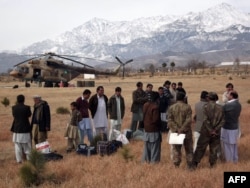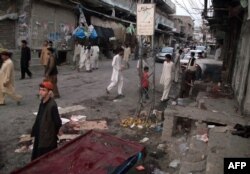A tiny Shi’ite minority survived years of siege and relentless militant attacks by taking up guns to defend their picturesque homeland in northwest Pakistan.
But Islamabad now wants the Shi’ite clans among the Turi and Bangash Pashtun tribes in Kurram tribal district to hand in their weapons.
Lawmaker Sajid Turi represents Kurram in the Pakistani Parliament. He says the region shares a border with Nangarhar Province in eastern Afghanistan, where Islamic State (IS) militants have held large swathes of rural territory over the past two years. Their presence in the region is marked by extreme atrocities against civilians and sporadic attacks against Shi’ite communities across Afghanistan.
“It is very clear the Shi’ite community here faces threats from extremist groups such as Daesh (eds: local name of IS) and Laskar-e Jahangvi,” Sajid told RFE/RL’s Gandhara website. “We are now really afraid that the dark days will return.”
As part of a disarmament drive in the Federally Administered Tribal Areas (FATA), authorities are attempting to collect “heavy weapons” -- including but not limited to landmines, anti-aircraft guns, mortars machines guns, rocket launchers, and rockets.
Kurram is one of the seven FATA districts where more than 50,000 civilians, soldiers, and insurgents were killed in a Taliban and Al-Qaeda insurgency that first began in 2004. Islamabad now claims to have cleansed FATA of militants and wants to control arms in the region.
Late last month, Brigadier Malak Amir Mohammad Khan, the local military commander in Kurram, told a tribal council to hand in their weapons by February 10.
“All the tribal areas have been cleansed of terrorists, and compliance with the law is the responsibility of every citizen,” he said.
Authorities are still allowing locals to keep handguns -- and even Kalashnikov or Ak-47 assault rifles -- but they want them to hand over stockpiles of rockets, bombs, mortars, and other military-grade weaponry.
Turi, however, says his constituents are yet not ready to surrender their weapons because Kurram is still threatened by suicide attacks and occasional missile strikes and insurgent forays from Afghanistan.
“Our people are yet not sure their circumstances have changed permanently. We feel threatened by Daesh,” he said. “We have suffered hard, and we don’t see any conditions that give us confidence that permanent peace has returned.”
Overshadowed by Safed Koh, Kurram descended into chaos in 2007 when rioting turned into sectarian clashes between Shi’a and Sunni Muslims in Parachinar. The leafy small border city, which serves as the headquarters of Kurram, soon turned into a ghost town.
As Parachinar's Turis pushed out its small Sunni population, their Sunni neighbors and Pakistani Taliban factions besieged the city by blocking the main road linking it to the rest of the country.
For the next four years, most young men among the region’s estimated 500,000 Turi and Bangash clans manned trenches in the style of World War I warfare. During that time, they assumed heavy machine guns, rockets, and mines to combat skilled Taliban fighters.
Their mountainous homeland, sometimes called the Parrot’s Beak, extends westward into Afghanistan and is hemmed in by the country’s Nangarhar and Paktia provinces on three sides. Over the past four decades, various militant groups viewed their homeland as a prized territory because of its proximity to the Afghan capital, which is less than 100 kilometers away.
The siege of Parachinar ended in 2011 when Kurram’s Shi’ite and Sunni clans made a peace deal after collectively enduring 3,000 deaths and thousands more casualties. Hundreds of thousands of civilians were also displaced by the fighting.
While a tenuous peace largely held during the subsequent years, Kurram’s Shi’ite communities were frequently targeted in suicide bombings and ambushes in the region.
Turi says many fighters from the Pakistani Taliban have now joined IS in Afghanistan. He backed Afghan government claims that a large number of IS fighters come from Orkazai, a tribal district bordering Kurram to the east.
He says Kurram’s Shi’a are not ready to believe in government promises that it will provide security because many soldiers of paramilitary Frontier Corps come from rival Sunni Pashtun clans.
“We have lost more than 3,500 people in violence since 2007. The Frontier Corps were here during that time, but they failed to either protect us or establish government authority in the region,” he said.
Such alleged failures have led tribal leader Haji Faqir Hussain to be skeptical of official pledges guaranteeing security. As the leader of Anjuman Hussaineia, a coalition of Kurram’s Shi’ite clans, he is not ready to disarm his community.
“Disarming [our] people at this moment is tantamount to tying their hands and feet,” he told the Pakistani daily, Dawn.
fg/









